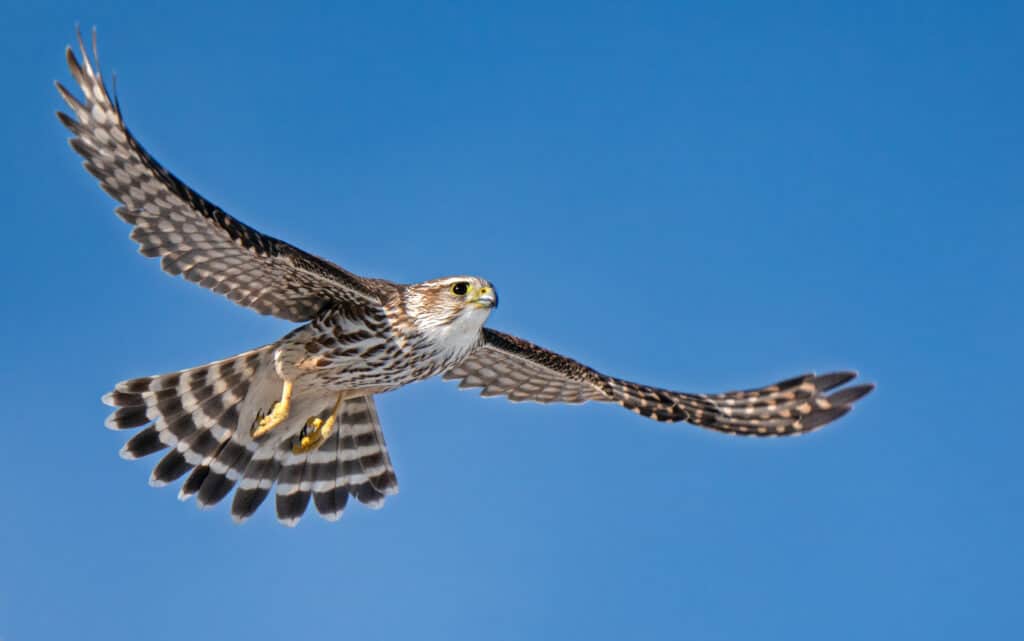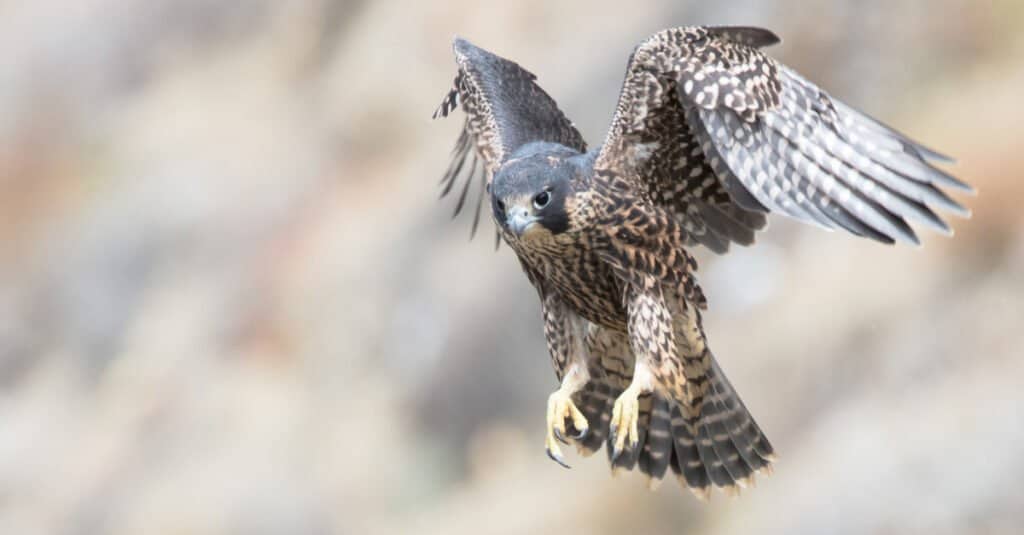There are hundreds of different types of birds in North Carolina. From songbirds to birds of prey, a simple glance into the Tar Heel State’s blue skies can introduce you to a variety of native species. Of these species, there are also several types of falcons in North Carolina.
To learn more about what a falcon is, as well as the species you may be able to see in North Carolina, continue reading below!
What Is a Falcon?
Falcons are raptors, or birds of prey, classified in the genus Falco. There are about 40 species that fall into this category, with them existing throughout the world. They can be found on all continents, excluding Antarctica. While this may be true in modern times, raptors closely related to those in the falcon genus did exist in Antarctica millions of years ago.

A falcon is any species in the genus
Falco.
©Harry Collins Photography/Shutterstock.com
The falcon has thin, tapered wings designed for high speeds. In fact, one species of falcon, which just so happens to be one of the types of falcons in North Carolina, is the fastest animal in the world! Unlike other raptors, who rely on their razor-sharp talons to secure prey, falcons have a specialized “tooth” at the end of their beak for catching prey.
Falcons who display different behaviors may receive additional names. For example, species of falcon that hover while hunting may be called kestrels, such as the common kestrel.
Types of Falcons in North Carolina
There are several types of falcons in North Carolina. Some of these are more common than others, with differences in year-round and migratory populations. Below, learn where to find these falcons in North Carolina, as well as how to identify them.
1. American Kestrel

Male American kestrels are the smallest falcons in North America.
©mynewturtle/Shutterstock.com
The American kestrel (Falco sparverius) is also known as the sparrow hawk, although it is neither. Males of this species are the smallest falcons in North America. They are also the most common falcon in this region. Adult American kestrels will grow to be around the size of a mourning dove, with a similar round body shape. However, they have shorter necks and hooked beaks.
American kestrels can be found throughout North America and South America. They have both migratory and year-round populations. In North Carolina, they are a year-round species found everywhere in the state. They favor areas such as American savannahs, with open space, low vegetation, and spare trees dotting the landscape. However, you can also find them in meadows, prairies, deserts, farmlands, and even urban and suburban areas.
Males are more colorful than females. Both sport rufous plumage on their backs with black-speckled markings. For the females, this color is also present on the wings, with a blue-gray cap. Males have both this blue-gray cap as well as blue-gray wings. Both sexes have white on the face framed by vertical black bars.
2. Merlin

Merlins can be identified by their barred tails and wings.
©Rob Palmer Photography/Shutterstock.com
The merlin (Falco columbarius) is another small species in this genus, once known as the pigeon hawk. However, unlike the American kestrel, which is found only in the western hemisphere, the merlin is native to the northern hemisphere. This includes North America and Eurasia. However, small populations can be found wintering in the northernmost regions of South America and Africa.
In North Carolina, merlins can only be seen during migration. However, during this time, they can be found throughout the state. The majority choose to settle in areas of open country. This includes areas with few trees but can contain shrubbery. They may also settle in grasslands.
The exact appearance of the merlin depends on the subspecies, as there are geographical variants. In North Carolina, you’re most likely to see the taiga subspecies on its migration from Canada to the southern regions of their range. Adults of this species are similar in appearance to the American kestrel. However, they are large, lack the white and black markings on the face, and lack the overall red coloration. Merlins have a buffy brown-and-white patterned chest, with their backsides and heads appearing a dark blue-grey color. The underside of their tails and wings may also be checkered.
3. Peregrine Falcon

Peregrine falcons are the fastest animal in the world, reaching speeds over 200 miles per hour when diving.
©TPCImagery – Mike Jackson/Shutterstock.com
Of the types of falcons in North Carolina, the peregrine falcon (Falco peregrinus) is the rarest. Known historically as the duck hawk, these high-speed raptors are found throughout much of the world, breeding in the north and wintering in the south. They can be found on every continent, excluding Antarctica.
In the majority of North Carolina, you’re likely to only see a peregrine falcon during migration. However, in this coastal region, this may vary. The northeasternmost region of North Carolina has a year-round population of these falcons, while the rest of the coast acts as a wintering ground for them.
Peregrine falcons have patterned undersides, with more white spacing than that of the merlin. Their most recognizable feature is their yellow eye ring, as well as their yellow and black beak.
The photo featured at the top of this post is © Harry Collins Photography/Shutterstock.com
Thank you for reading! Have some feedback for us? Contact the AZ Animals editorial team.







